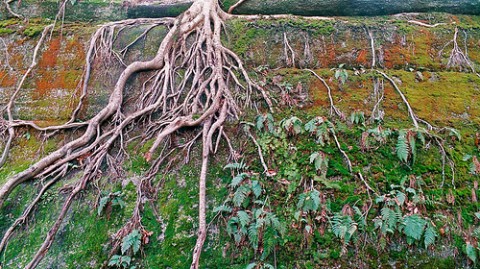Tag Archive: systems
February 24, 2014

Enjoy these simple and powerful guidelines from Beth Kanter about how movement makes meetings and workshops more productive. This is great advice for getting beyond designing for “brains on sticks” as my colleague Curtis Ogden likes to say.
As a trainer and facilitator who works with nonprofit organizations and staffers, you have to be obsessed with learning theory to design and deliver effective instruction, have productive meetings, or embark on your own self-directed learning path. Learning theory is an attempt to describe how people learn. There are many learning theories and can be categorized in different ways:
Read More
February 21, 2014
This post is the third in a three part series exploring the question, “Can collaboration be learned?” Part 1 and Part 2 appeared the last couple of days. This is an edited email exchange between Alison Gold of Living Cities, Chris Thompson of The Fund for our Economic Future, and myself. When we last left off, Alison had posed a series of questions about identifying and cultivating the will to collaborate.
On January 27, 2014 12:33 PM, Curtis Ogden wrote:
Alison, I really like your questions and feel like they would be great to take to a wider audience. I will say that I am profoundly influenced by Carol Sanford’s mentoring in all of this, and the belief that personal development is key to evolving our will, moving from a more self-centered perspective to “other” perspective, to understanding the symbiotic nature of different levels of systems. Read More
December 17, 2013

Stowe Boyd has posted a provocative and largely resonant manifesto on the future of work. Our ways of doing business are thoroughly obsolete, “only 29% [of workers] are actively engaged with work.” If this obsolescence is true for the private sector, it is even more true for those of us who work for justice.
Read More
September 12, 2013
“If what we change does not change us we are playing with blocks.”
– Marge Piercy

|Image by Nico Paix|http://www.flickr.com/photos/91845235@N00/6523944047/in/photolist-aWuVgV-84KnUQ-9p5Xr2-e7QpWv-fr9W96-bYrHxs-aamm8N-bfB8Bn-bh5d8M-9JejMT-bh4YjD-bq9z27-bD4txZ-bD4tye-dgEWqj-8AwwCb-a2hh5y-aGsxtr-7Rg5mV-7Rjmeb-7Rjm9U-7Rjm79-7RjmfS-7Rg5rR-7RjkVE-7RjmeU-7RjkUJ-7Rg5uK-7Rjm1C-7Rjmdh-7Rg5hM-7Rjmch-7Rjm95-7RjkS5-7Rg5iR-7Rjm2o-7Rjm5s-7Rjmgo-7RjkTS-7Rg5nM-7Rg5vv-7Rjm6m-7RjkWW-caM8Bm-dgtEDV-9p5VLa-7CdrXE|
At IISC we see taking a developmental view as being critical to effective collaborative and network-based approaches to social change. This is largely because of the complexity of the issues we are striving to address with our partners and the “adaptive” nature of the work. It is also because we hold an evolutionary perspective; that is, we see change and development as being part of the underlying dynamic of reality. As scientist and Jesuit priest Pierre Teilhard de Chardin once declared, “We are moving!” And so we are interested in paying attention to and working with evolution as it occurs at different levels – individual, team/group, organization/institution, community, etc. Read More
September 4, 2013
“Look to the growing edge!”
– Howard Thurman

|Photo by Derek Keats|http://www.flickr.com/photos/93242958@N00/5975110268/in/photolist-a7117y-emRe8S-dQqpqM-9php24-dQvZtC-8YMYMv-7zavYz-e1zkdz-aLCNuz-9MeCHk-9MfzYB-9MekHF-9Mho3b-89vnnr-9MfG9c-9Mhaow-9D8j3o-9Mehua-9Mh72m-aykWRY-cCSWHs-8MqWXJ-9LFCBt-9MiH7w-9Mh12x-93HasG-azHpQX-aXCs8V-ejaBn1-byQPHp-bkVXyG-byQQ5x-byQPJv-bkVXGC-bkVXGo-a6ZZM9-a6ZZzU-a6ZZqY-8NyJ6R-8NywQV-8NBWXy-8NysTX-8NBpXW-8NC1BU-8Nz18e-a6X98i-a6ZZ7U-8NyEJB-bkVXoL-bkVXwG-byQPMZ|
Edge has its advantages. This is the finding of ecologists and other scientists looking at how peripheral spaces can provide adaptive strength. For example, where different habitats meet, there is considerable fecundity and the extent to which there is more significant overlap there is that much more richness and species able to thrive in more than one setting. Trees make interesting use of edge by maximizing the surface area of their root systems to find and take in nutrients in the soil. We also know that innovation tends to happen where different disciplinary fields meet, and therefore through a porousness and openness to new thinking on the edge. Read More
August 26, 2013

We partnered with a foundation as they built a network of leaders who shared a deep passion for their city. In the beginning, many of the leaders wanted to do something together quickly. We encouraged them to pause, build deeper relationships, and see what emerged. Read More
August 19, 2013

The following blog post is Part 3 of a series dedicated to Race and Social Transformation. We encourage you to share and comment!
Transforming racism is hard work! The complexity doesn’t automatically mean current efforts aren’t working. Still, many are searching for new ways to deepen their effectiveness. At IISC, we see focusing both on content (what can we do about racism) and process (how we engage with one another) as a powerful way forward. Consider a few examples that flow from our practice.
Read More
August 13, 2013

How to predict the future? It’s a bit like the alchemist’s dream, ever-seductive wishful thinking. We can’t predict the future, not with master plans and not with meta-data. Too many of the problems within organizations have to do with our frustrated wish for someone – ideally “the leader” – to be able to predict the future and to create stability for us. Read More
August 5, 2013

The following blog post is Part 1 of a series dedicated to Race and Social Transformation. Special thanks to Gibrán Rivera, Miriam Messinger, Curtis Ogden, Sara Oaklander, Mistinguette Smith and Maanav Thakore for their support in completing this series! We encourage you to share and comment!
In the U.S., the work of transforming racism is often stuck in an unproductive binary: either transform people or transform systems. Fortunately, more and more people recognize that we have do both and more. Read More
July 29, 2013

We facilitated a network focused on improving early childhood education and care. The initial focus was to build leadership capacity and facilitate strategy development with stakeholders across a state to design a more holistic statewide structure for decision-making related to early childhood. Read More
July 16, 2013

This is for the kids who die,
Black and white,
For kids will die certainly.
The old and rich will live on awhile,
As always,
Eating blood and gold,
Letting kids die.
Read More
July 15, 2013

This morning we came into the IISC Boston office ready for a two-hour staff meeting and a four-hour training. We sat down, looked around the table, and began with a question not about what was on the agenda, and instead about what was present in the room. The question was: How does the Zimmerman verdict affect us and our work at IISC?
Read More











